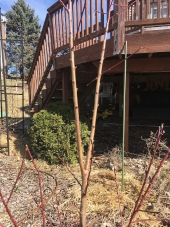


Ralph Sluder wrote: i would trim both limbs back about 1/3 from tips. Then I would probably put a stick or something between them to allow them to grow apart a little. On peaches you want to finish with a vase shaped, open centered tree.
That's how we do them around here in south Ga. Looks like there growing nicely.



Michelle Heath wrote:Greg, I'm hoping to take some elderberry cuttings soon. I've had really good luck with rooting other soft and hardwood cuttings in a clear plastic tote with a lid in a shady spot in my backyard. I'm doing individual cuttings in clear plastic cups in which I've drilled a few drainage holes. The clear cups lets you see when the roots have formed and you vent the lid on the tote as needed. I had an empty cup of soil and put a tomato sucker in it and had no wilting whatsoever and roots within a week. Of course elderberries probably won't root as fast as tomatoes, but keeping conditions humid inside the tote is what really makes a difference.
Tj Jefferson wrote:In my experience ribes love love love wood chips. If you can get (really any) mulch they will love you. They are constantly making new roots so its no big deal how you planted them as long as they have some water and tilth to work with.